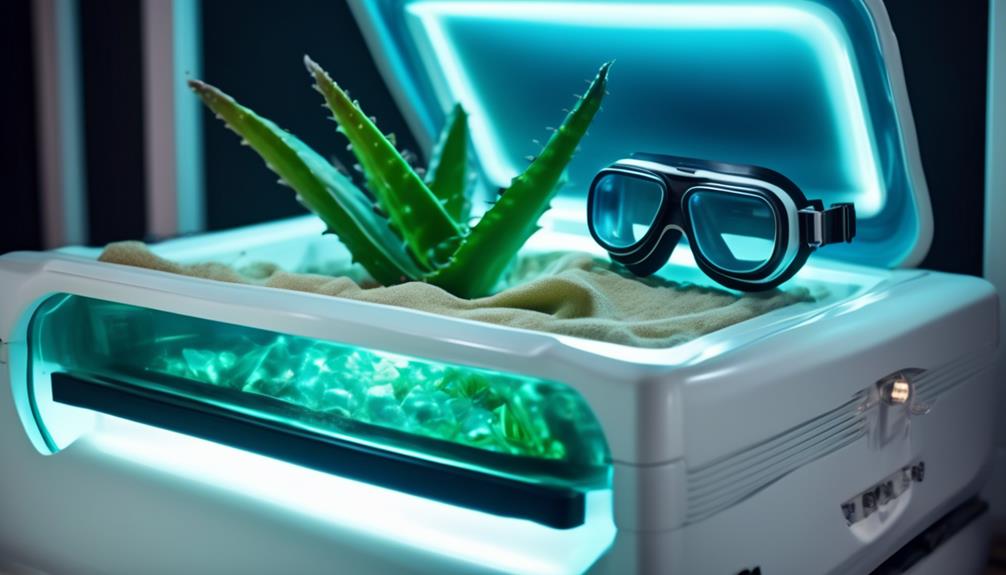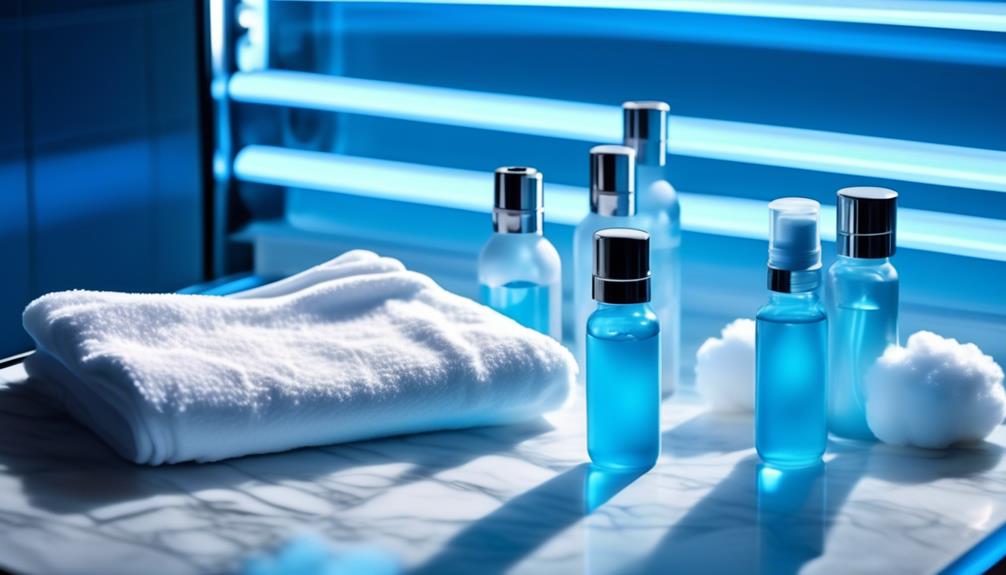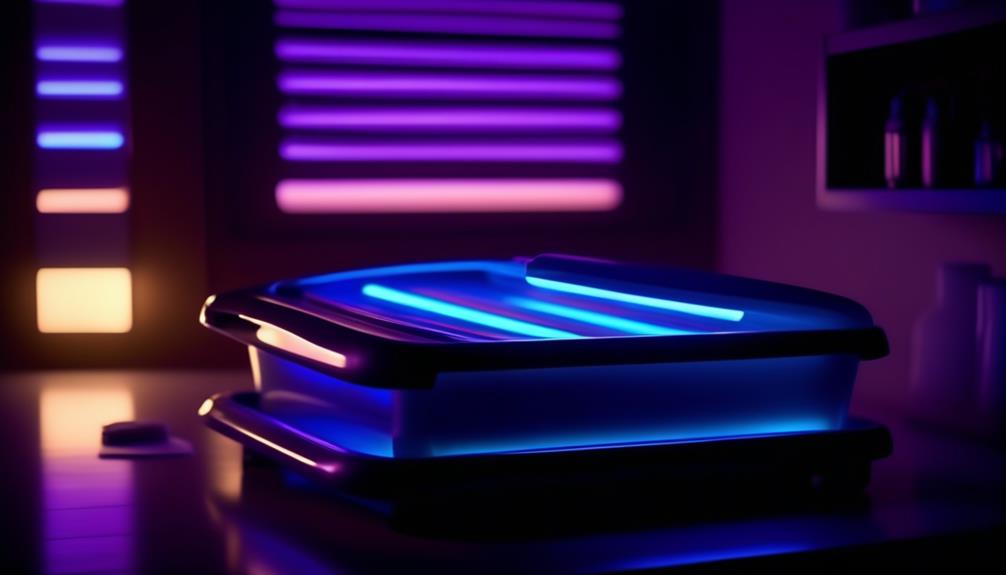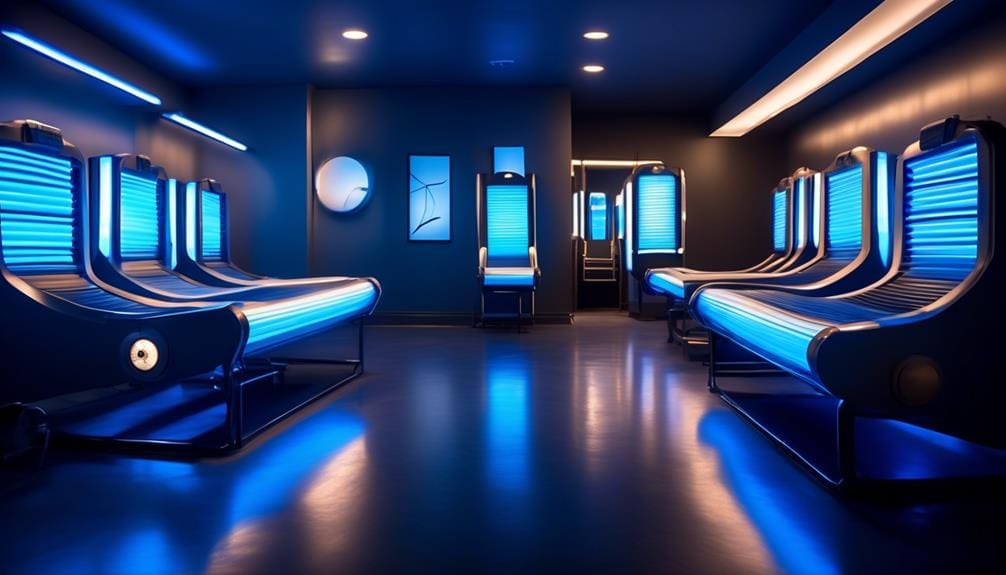Did you know that indoor tanning beds can emit UV radiation up to three times stronger than what you’d catch lounging on the beach? That’s a pretty wild stat that might have you rethinking your next session.
So, you’re standing there, faced with a choice between a UVB or UVA tanning bed, and it’s crucial to know what’s what. UVB beds might give you that quick hit of color, but at what cost? And sure, UVA beds promise a deeper tan, but let’s talk about what ‘deep’ really means for your skin.
We’re about to get under the skin of these tanning giants, comparing the risks, results, and why you might want to pause before you bronze. Trust me, there’s more to this than just picking the bed that gets you the darkest tan.
Let’s peel back the layers and see what’s really going on when you’re soaking up those artificial rays.
Key Takeaways
- UVA tanning beds emit intense UVA radiation, increasing the risk of skin damage and cancer.
- UVB tanning beds can boost vitamin D production and stimulate the production of melanin, providing some benefits to bone health, the immune system, and relief for skin conditions like psoriasis.
- Both UVA and UVB rays carry risks to skin health, including skin damage and an increased risk of skin cancer.
- Understanding one’s skin type, using protective measures like eyewear and sunscreen, and consulting a dermatologist are important for safe tanning bed use.
Tanning Bed Basics
Let’s understand the nitty-gritty of tanning beds: they’re not just sun-kissed skin factories, they’re also UV radiation powerhouses that can seriously crank up your risk of skin drama.
You might think you’re basking in a golden glow, but you’re actually soaking up a cocktail of UVA and UVB rays that could spell trouble for that gorgeous epidermis of yours.
When you waltz into tanning salons, those beds are primed to emit UVA rays that penetrate deep, giving you that tanned look you’re craving. But it’s a double-edged sword. UVB tanning might give you a quick color boost, yet it’s also doing a number on the surface of your skin, potentially leading to a nasty sunburn situation.
Those artificial tanning machines pump out up to three times more intense UVA radiation than what you’d get lounging under the natural sun. And let’s keep it real, that’s a one-way ticket to Wrinklesville and could put you on the fast track to skin cancers like melanoma, and nobody’s got time for that.
UVA Tanning Effects
Let’s get real about what those UVA rays are actually doing to your skin – it’s not just the tan you’re walking away with.
You’re signing up for a dose of risks that could lead to wrinkly, saggy skin, and yeah, even skin cancer.
UVA Exposure Risks
While exploring UVA tanning effects, it’s clear that the deep skin penetration by UVA rays isn’t just giving you that golden glow—it’s also speeding up the aging process and upping your skin cancer risk. Let’s get real about what’s happening when you’re soaking up those rays in a tanning bed:
- UVA rays damage the deeper layers of your skin, leading to fine lines and wrinkles way before your time.
- Skin cancer fears? They’re legit. UVA ups the odds for not just melanoma but also basal and squamous cell carcinomas.
- UV exposure in tanning beds can be triple the intensity of the sun—talk about an overdose for your skin.
- Indoor tanning isn’t a safe bet. That controlled environment? It’s still packing a high cancer risk punch.
Tanning Process Understanding
Understanding how UVA rays in tanning beds can tan your skin is crucial, especially since this bronzed effect comes with a hidden cost to your health.
When you lie in a tanning bed, soaking up those intense UVA rays that go deep – and I mean, really deep – into your skin, you get that golden glow. It’s the result of your skin’s defense mechanism kicking in.
But here’s the kicker: those same rays are notorious for causing some serious skin damage and, let’s not sugarcoat it, upping your risk of skin cancer. And unlike their UVB buddies, UVA rays offer you zero photoprotection perks.
UVB Tanning Benefits
While soaking up some UVB rays in a tanning bed might sound like a guilty pleasure, it’s also a way to boost your body’s vitamin D levels and give your skin a little love. Let’s get real: we all crave that sun-kissed glow, but it’s not just about looking fab. Those UVB rays are working some undercover magic for your well-being, too.
Now, don’t get it twisted – moderation is key, ’cause you don’t want to hike up your skin cancer risk, including melanoma.
Here’s some details on how to use UVB rays responsibly.
- Vitamin D Boost: UVB triggers vitamin D production, which is like a high-five for your bones and immune system.
- Skin Condition Relief: Battle stations for conditions like psoriasis – UVB can help send them packing.
- Natural Armor: Melanin, your skin’s personal bodyguard against UV damage, gets a boost, reducing the chance of a nasty sunburn.
- Mood Lifter: Feeling down? UVB can help kick those blues to the curb by upping your vitamin D and serotonin levels.
Skin Type Considerations
Before you hit the tanning bed, it’s super important to know that not all skin is created equal – your skin type dictates how much sun love you can safely handle. If you’re rocking that fair skin, you’ve got to be extra with your approach to UV tanning. Those UVB rays? They’re the flirty ones that can give you a sunburn faster than you can say ‘ouch.’ And don’t be fooled, UVA rays are the silent charmers, creeping in deep, and they can mess up your skin vibe over time.
Now, if you’re blessed with a darker tone, you’ve got a bit more natural armor against those UV ambushes, but don’t get it twisted – you’re still in the crosshairs for skin damage. It’s like wearing a thin jacket in a hailstorm; it helps but doesn’t make you invincible.
If you’ve got a history that includes skin cancer or your skin just throws a fit when the sun looks at it, then you better slather on that high SPF sunscreen like it’s your shield in battle. Remember, understanding your skin type isn’t just self-care – it’s your strategy to keep your glow game strong without letting UV rays play you.
Safety Measures
Let’s get down to brass tacks: UV radiation from tanning beds is a known carcinogen, and that’s no joke. The less you expose yourself, the lower your risk for melanoma and other skin cancers. Plus, we can’t forget about the premature aging that comes from UV damage—hello, wrinkles!
Here’s some tips on staying golden without getting burnt:
- Block the Peepers: Always sport protective eyewear. Your eyes can’t handle that UV intensity.
- Chill with the Bake Time: Keep the sesh short and sweet. Less is more when you’re playing with UV rays.
- Lube Up: Slather on that tanning bed lotion. It’s like sun protection and a skin quencher in one.
- Doc Talk: Hit up your dermatologist. They’re the real MVPs for keeping your skin in the game.
Achieving Desired Results
If you’re gunning for that sun-kissed glow, know that tanning beds pack a punch with intense UVA rays, getting you bronzed up but at a cost. These bad boys penetrate deep, working their magic on your existing melanin to fast-track that golden hue you’re after. But don’t be fooled; while you’re basking in the faux sun, those UVA rays are cozying up to your skin cells in ways that mightn’t end well.
Dabbling with UVB rays? They’re the rougher touch, more likely to leave you with a sunburn than a tan. Sure, they contribute to that tanning effect you crave, but they’re also flirting with danger, causing superficial skin cell damage that’s no joke.
Let’s keep it real, tanning is your me-time, your escape. But as you chase that bronzed perfection, remember the flip side. You’re rolling the dice with your skin health every time you slide into that tanning bed. The desired results might look hot now, but the risks? They’re just as intense as the UVA and UVB rays you’re soaking up.
Proper Lotion Selection
Don’t just grab any old bottle off the shelf! You’ve gotta pick a lotion that packs a high SPF punch to keep those UVA and UVB rays in check.
Keep it skin-smart with a formula that’s all about that moisture balance – because nobody’s here for that dried-out look.
Lotion Ingredients Matter
Choosing the right tanning lotion isn’t just about smelling beachy; it’s science for your skin that can amp up your glow and keep your hide hydrated. The tanning industry is all over the harmful UV narrative, so when you’re prepping for some ultraviolet (UV) radiation rendezvous, lotion ingredients matter big time.
Your skin’s begging for more than just a tan; it needs TLC to combat that UV sass.
Here’s your must-have checklist:
- Moisture-Rich Goodness: Aloe vera and glycerin are your BFFs for keeping things plush.
- Tan Boosters: Tyrosine and riboflavin aren’t just fancy words—they’re tan-thirsty heroes.
- Bronzer Bonus: Get that instant bronze goddess vibe while your tan’s baking.
- Antioxidant Armor: Vitamin E’s your knight against the premature aging dragon.
Swipe on the right potion and tan responsibly!
SPF Inclusion Importance
Slathering on the right SPF-packed lotion is your skin’s secret weapon against those sneaky UV rays. Think of it as your intimate shield, the barrier that whispers, ‘Not today, sunburn!’ and ‘Hold up, skin aging!’ every time you bask in that bronze glow.
The SPF inclusion importance can’t be overstated. Those ultraviolet rays are out to get you, ready to cause sunburn and fast-track the fine lines that tell tales of too much sun.
Going for a broad-spectrum sunscreen with a high SPF, like 30 or more, is non-negotiable. It’s like wearing a full suit of armor in a sun battle. Remember, tanning beds aren’t your skin’s BFF.
Put skin health on a pedestal, and make SPF your ride-or-die.
Moisturization and Tanning Balance
While you’ve got your SPF game on lock to shield against UV damage, let’s not forget the role a killer moisturizer plays in keeping your tan game strong and your skin supple.
Whether you’re soaking up natural sunlight or hitting the tanning bed, UV rays are thirsty for your skin’s moisture. They’ll snatch it up, leaving behind damage in the skin that can mess with your immune system.
So, here’s the real talk on moisturization:
- Look for lotions packed with antioxidants.
- Hyaluronic acid is a hydration hero.
- Avoid products with alcohol – they’re secretly drying.
- Slather it on post-tan to lock in color and hydration.
Stay dewy. Your skin’s health is worth it.
Tanning Duration Guidelines
To keep your glow game strong and skin safe, cap your tanning bed sessions at a max of 15 minutes, and that’s non-negotiable. Those UV rays cause more than just a pretty tan—they can do a number on your skin, think DNA damage and, yikes, even melanoma. So, let’s play it smart, okay?
Starting slow is your best bet. If you’re new to the tanning bed scene, ease into it. Don’t just jump in full force—your skin’s not ready for that kind of commitment. Gradually increase your time under those glowing beds, but always keep an eye on the clock. Overstay your welcome, and you’re asking for a burn, not a bronze.
Remember, your skin’s as unique as you are. Some folks might be fine with a full 15, but if your skin’s on the sensitive side, you might need to cut it short. And always, always follow the tanning bed’s guidelines—they’re there for a reason.
Now, don’t forget those goggles! Your peepers need protection from UV exposure just as much as your skin does. Keep ’em covered and keep track of time. Your skin will thank you with that gorgeous glow, all while staying in the safety zone.
Aftercare Recommendations
Now that you’ve capped your tan time, let’s talk aftercare to keep that skin soothed and fab. Hitting the tanning bed might’ve given you that glow-up, but , don’t forget about the TLC your skin desperately needs afterward.
Exposure to UV rays, whether from a sizzling session or the sun’s own salon, can be tough on your skin, upping the chances of sun damage and, yikes, even skin cancer.
Here’s some tips on keeping your skin game strong and healthy:
- Chill on the UV: Give your skin a break from all things UV, including those sneaky sun rays and tanning beds. Melanoma is no joke, love.
- Moisturize like a boss: Slather on those soothing creams and lotions to kick any dryness or irritation to the curb.
- Get a skin check: Play it safe and let a dermatologist take a peek for any signs of trouble. Catching changes early is key.
- Hydrate, hydrate, hydrate: Water is your bestie, so drink up to keep your skin and body in tip-top shape.
Don’t slack on your aftercare; it’s the secret sauce to maintaining that radiant tan without the ouch. Keep it smooth, keep it safe!
Frequently Asked Questions
Are UVB Tanning Beds Safe?
Think twice about UVB tanning beds. They’re not your skin’s BFF. Sure, controlled sessions might sound safe, but they still up your chance of a nasty burn and, worse, skin cancer.
Plus, you don’t need a bed to snag that vitamin D.
So, why gamble with your health?
Keep it real and embrace your natural radiance or find a safer way to bronze up.
Is UVB or UVA More Harmful?
UVB’s got a rep for burns, but UVA’s sneaky — it goes deep, aging your skin and upping cancer risks. Neither’s your friend, honestly.
Tanning beds crank up UVA, thinking it’s safer. Spoiler: it’s not. You’re playing roulette with your skin every time.
Better to embrace that natural glow and dodge those risky rays.
Stay safe!
Which Type of Tanning Bed Is Safest?
There isn’t a ‘safest’ tanning bed.
They all pose risks, and you’re better off steering clear.
If you’re craving that sun-kissed glow, fake it, don’t bake it. Opt for a good bronzer or a spray tan; your skin will thank you later.
Remember, those rays in tanning beds are no friends of yours—they’re just freckle-inducing, wrinkle-causing frenemies.
Play it safe and keep it fake, okay?
Which Is Better UVA or UVB Tanning Beds?
Neither UVA nor UVB tanning beds are your friends.
You’re risking serious skin damage and upping your cancer odds with both.
If you’re aiming for that glow, grab some self-tanner or hit the spray booth instead. It’s way healthier, and you’ll still look fab.
Plus, you won’t be gambling with your skin’s future – that’s a win-win in anyone’s book.
Stay safe and rock that bronzed look, okay




